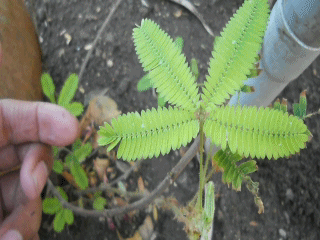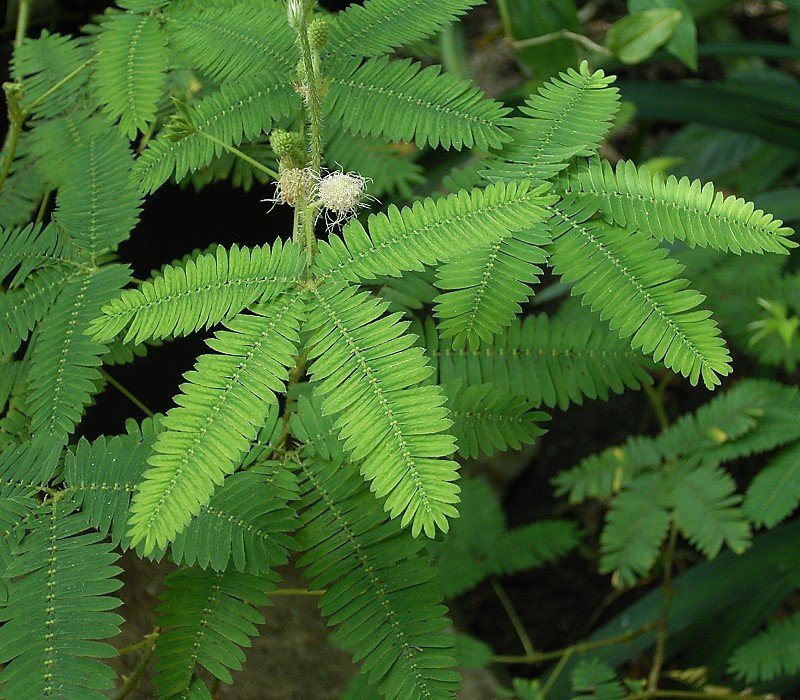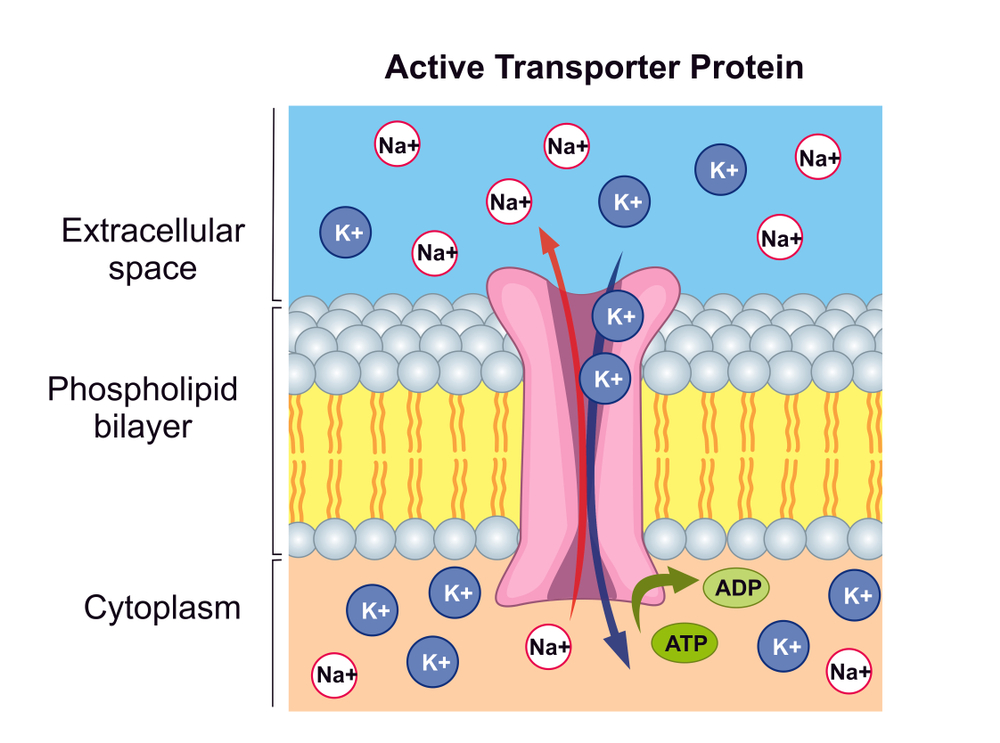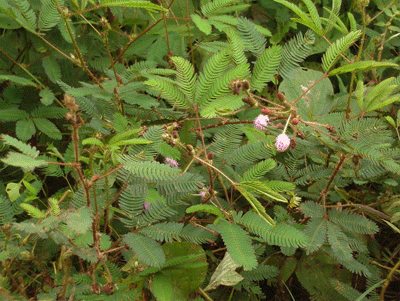Mimosa pudica bends upon being touched. This occurs due to changes in the turgor pressure in its cells. The behavior is a predator avoidance mechanism.
Mimosa pudica is a perennial herb of the Fabaceae pea family, native to Central and South America. Commonly called the touch-me-not plant, the sensitive plant, or the ‘Tickle Me plant’, it is known for closing its leaves or folding them inwards when touched.

When it comes to playing with plants, there is no greater pleasure than touching the leaves of the “touch-me-not” plant and watching them recoil, shrink and “go to sleep.” I did this a lot as a child and still do it when the opportunity presents itself. As an adult, I have often wondered what causes such a response from the plant and how it manages to do this.
The Mimosa pudica Shows Thigmonasty
Although there are many colloquial names for this unique plant, botanists and the rest of the scientific community call it Mimosa pudica. It is a perennial herb of the Fabaceae family, in the genus Mimosa, and it is native to Central and South America.
Mimosa pudica is not the only Mimosa plant to exhibit ‘rapid plant movement’; it is simply the most popular. In 300 BC, the Greek philosopher Theophrastus mentioned a plant that would ‘wither up and collapse’, and then after a time come to life again and flourish. The plant Theophrastus was referring to was most likely part of the genus Mimosa and, according to some research, could have been the species M. asperata.
These rapid movements aren’t unique to Mimosa species. Carnivorous plants such as the Venus flytrap employ rapid movements to capture their prey. Species such as the cactus Lophophora williamsii and the plant Cornus canadensis spread their pollen by shooting out their stamens when they experience touch. The plants in the Cardamine species have seeds that explode when touched.

These are called nastic movements – movements that occur in response to a stimulus. If the stimulus is a touch or contact stimulus such as the wind, they are called seismonastic movements or thigmonasty. If the stimulus is heat, they are called thermonastic movements. If they are light reactions, the movements are photonastic, while day and night-based movements are called nyctinastic movements.
Also Read: What Is Thigmotropism?
Mimosa pudica‘s Leaves Bend Due To A Change In Turgor Pressure Of Its Cells
Mimosa pudica not only responds to seismonastic movements; it also closes upon being heated. When the plant is exposed to such stimuli, it undergoes a series of biochemical and bioelectrical changes that allow it to bend inwards.
The movement originates at the pulvinus, pad-like swelling of petioles and stems that have the ability to twist, which allows them to move. There are two cell types in the pulvinus: the extensor cells and the flexor cells, which are located opposite each other. If the plant experiences a touch, the extensor cells flex while the flexor cells stretch and create the movement.
This bending occurs due to a change in the turgor pressure of the extensor cells. The turgor pressure is the force that the water within the cells exerts on the cell walls, helping the cells to maintain their shape.
The stimulus (touch) leads to potassium (K+) ions and chlorine (Cl-) ions exiting the cells. Reduced concentrations of ions from the inside of the cells and the subsequent increase to the outside create a chemical gradient, leading to water molecules leaving the cell through osmosis.

Water leaving the extensor cells leads to decreased turgor pressure, causing the cells to become flaccid and bend.
However, these aren’t the only changes. Another potentially simultaneous mechanism might be the release of sucrose from the phloem into the apoplast, the extracellular area of a plant. This also promotes osmosis.
Within the extensor and flexor cells, there is evidence that the cytoskeleton, the protein chains that help the cells maintain their shape, also changes to allow the cells to flex.
A stimulus spreads throughout a branch via an electrical signal, similar to a neuron. So although a part of the branch has experienced the stimulus, all the leaves on that branch would still shut in response.
The exact mechanism by which such electrical signals are propagated in plants hasn’t been fully elucidated. Some research has shown that the signal may migrate through companion cells and phloem cells within the plant, while other research has implicated the xylem and changes in its pressure.
Mimosa pudica Folds Its Leaves As A Predator Avoidance Mechanism
The process of folding and recoiling leaves costs the M. pudica a lot of energy (Source). While the leaves are bent, the opportunities to photosynthesize and produce energy are also reduced. If it causes the plant to waste energy and lose opportunities to produce more energy, why should a plant have such a wasteful mechanism?
Researchers believe that the trait evolved as a way to avoid predators. If a herbivore comes along and starts nibbling on the Mimosa plant, bending the leaves inwards and drooping would make it more difficult for the predator to tear off the leaves, and it would also serve to expose thorns.
Drooping also gives the impression that the plant is dead or dying and is therefore not as appealing as fresher, potentially more nutritious plants. Furthermore, it’s also believed that such rapid movements help the plant dislodge insects that may threaten certain parts of the plant.

There is always an energy trade-off when it comes to predatory avoidance behaviors, and Mimosa plants take a risk every time they close. Studies on the effect of light intensity have shown that the Mimosa plant takes more time to reopen its leaves under high light conditions, which means that it is willing to take a greater risk to avoid predators when light is abundant.
However, Mimosa’s response isn’t consistent across all stimuli. Just as animal responses become dulled or get habituated to certain repeated stimuli, especially those that aren’t life-threatening (like a loud, repeating sound), research has shown that the movements of the Mimosa plant also show habituation. A study published in 2014 showed that M. pudica shows learning behaviors towards certain stimuli under favorable environmental conditions. Behavioral research in plants is still in its infancy but has exciting potential to teach us about how life “learns” and how such behaviors might have evolved.
Also Read: Can Plants Hear, Smell, See, Touch Or Taste Stuff?
Test your knowledge on the Mimosa pudica plant
Can you answer three questions based on the article you just read?

References (click to expand)
- Braam, J. (2004, November 17). In touch: plant responses to mechanical stimuli. New Phytologist. Wiley.
- Kameyama, K., Kishi, Y., Yoshimura, M., Kanzawa, N., Sameshima, M., & Tsuchiya, T. (2000, September). Tyrosine phosphorylation in plant bending. Nature. Springer Science and Business Media LLC.
- Jensen, E. L., Dill, L. M., & Cahill, J. F., Jr. (2011, March). Applying Behavioral-Ecological Theory to Plant Defense: Light-Dependent Movement in Mimosa pudica Suggests a Trade-Off between Predation Risk and Energetic Reward. The American Naturalist. University of Chicago Press.
- Gagliano, M., Renton, M., Depczynski, M., & Mancuso, S. (2014, January 5). Experience teaches plants to learn faster and forget slower in environments where it matters. Oecologia. Springer Science and Business Media LLC.
- Sibaoka, T. (1969, June). Physiology of Rapid Movements in Higher Plants. Annual Review of Plant Physiology. Annual Reviews.
